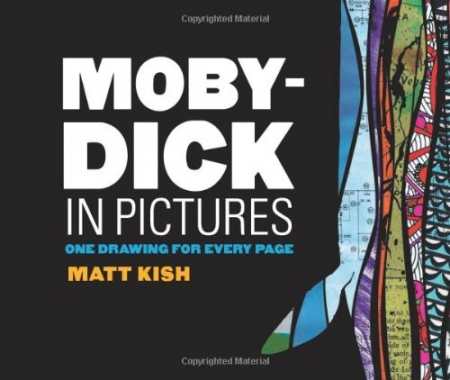Moby-Dick in Pictures
One Drawing for Every Page
But he will still be hunted, for all that. What is best let alone, that accursed thing is not always what least allures. He’s all a magnet!
To borrow from Herman Melville, the “accursed” things that attract us aren’t always conscious choices; then again, sometimes they’re painfully so. Every day, for eighteen months, Ohio librarian Matt Kish spent his time apart from work in a closet-sized room illustrating one page of his favorite book, the epic Moby-Dick. Obsessive? Brave? Nutty? Just as the quest for the white whale took on mythic proportions in Ishmael’s telling, the scope of Kish’s project—a labor of love if ever there was one—can resemble that of the characters he so admires.
“This is how Moby-Dick looks to me,” explains the formally untrained artist. “This is the book I have always wanted.” A fan of Captain Ahab’s story since he watched Gregory Peck in that 1956 film role, and an admirer of Zak Smith’s illustrated Gravity’s Rainbow, Kish was not to be outdone in honoring his own accursed thing. He selected a paperback version from Signet Classics, with the story’s pages totaling 552. As if his attempt weren’t impressive enough, Kish’s results are often exceptional.
He used acrylic paint, ink, ballpoint pen, marker, pencil, colored pencil, and charcoal, mostly on found paper, specifically the pages of instruction manuals, the partial diagrams and words of which are visible at the edges and underneath his own work. “Melville’s book is so densely, deeply, and at times confusingly layered with narrative and symbolism that I wanted to mirror that structure in the art I was making.”
Conjuring the frenetic energy of the tempest-tossed waves so integral to Moby-Dick’s setting, the artist’s bold, full-page drawings in highly saturated colors illustrate passages he’s called out, but also extend the narrative to suggest that modern-day man hungers to fulfill his self-proclaimed destiny every bit as much as the legendary whalers did. The past holds an allure for Kish in other ways, too. “In an environment absolutely saturated with digitally created content, where original art often never really exists as a physical object and is instead simply a JPG on a computer somewhere,” he explains, “it was deeply important to me to reconnect these Moby-Dick illustrations with the older and more physical world of books and printing.”
The librarian’s proficiency with words, and with cataloging and indexing, is evident throughout this colossal project, but it is clearly infused with an intense joy that only comes from following one’s heart.
Reviewed by
Julie Eakin
Disclosure: This article is not an endorsement, but a review. The publisher of this book provided free copies of the book to have their book reviewed by a professional reviewer. No fee was paid by the publisher for this review. Foreword Reviews only recommends books that we love. Foreword Magazine, Inc. is disclosing this in accordance with the Federal Trade Commission’s 16 CFR, Part 255.

